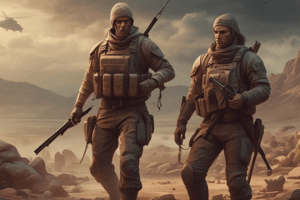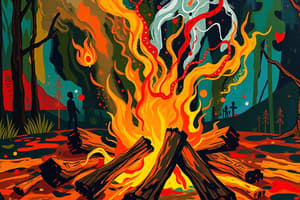Podcast
Questions and Answers
What are the three main components of the Survival Triangle?
What are the three main components of the Survival Triangle?
- Mental Edge, Tactical Awareness, Shooting Skill
- Mental Edge, Physical Preparation, Tactics
- Mental Edge, Physical Preparation, Shooting Skill (correct)
- Physical Preparation, Tactical Awareness, Shooting Skill
A prepared mind is not as important as physical preparation.
A prepared mind is not as important as physical preparation.
False (B)
What is the term used to describe the strain placed on your internal system by anything that disturbs or makes a demand of you?
What is the term used to describe the strain placed on your internal system by anything that disturbs or makes a demand of you?
Stress
_________ is a stress response where you mentally block out part of a stressful episode while it's happening and when it is over.
_________ is a stress response where you mentally block out part of a stressful episode while it's happening and when it is over.
Match the following stress responses with their descriptions:
Match the following stress responses with their descriptions:
What is the term used to describe the area around an officer that needs to be considered when making decisions?
What is the term used to describe the area around an officer that needs to be considered when making decisions?
Condition Yellow indicates an immediate and present danger.
Condition Yellow indicates an immediate and present danger.
What are the four steps to tactical thinking?
What are the four steps to tactical thinking?
The principle of ______ emphasizes maintaining tactical separation between officers and suspects to minimize crossfire.
The principle of ______ emphasizes maintaining tactical separation between officers and suspects to minimize crossfire.
Match the following tactical positions with their descriptions:
Match the following tactical positions with their descriptions:
Which of these is NOT a fatal error according to the provided content?
Which of these is NOT a fatal error according to the provided content?
Concealment provides protection from an attack.
Concealment provides protection from an attack.
Explain "On-Cover" and "Off-Cover" positioning in terms of tactical advantages.
Explain "On-Cover" and "Off-Cover" positioning in terms of tactical advantages.
The ______ officer is responsible for conducting verbal communication with the suspect during a threshold inquiry.
The ______ officer is responsible for conducting verbal communication with the suspect during a threshold inquiry.
Condition Black describes which state of mind?
Condition Black describes which state of mind?
Flashcards
Survival Triangle
Survival Triangle
A model emphasizing the importance of mental readiness and physical training.
Stress
Stress
The strain placed on your internal system by demands or disturbances.
Startle Response
Startle Response
Involuntary reactions to sudden fright, like jumping at a loud noise.
Tactical Breathing
Tactical Breathing
Signup and view all the flashcards
Condition Yellow
Condition Yellow
Signup and view all the flashcards
Condition Red
Condition Red
Signup and view all the flashcards
Tombstone Courage
Tombstone Courage
Signup and view all the flashcards
Contact Officer
Contact Officer
Signup and view all the flashcards
Cover Officer
Cover Officer
Signup and view all the flashcards
Principle of Triangulation
Principle of Triangulation
Signup and view all the flashcards
Position 1
Position 1
Signup and view all the flashcards
Defensive Stance
Defensive Stance
Signup and view all the flashcards
Cover vs. Concealment
Cover vs. Concealment
Signup and view all the flashcards
Basic Stance
Basic Stance
Signup and view all the flashcards
Study Notes
Survival Triangle Fundamentals
- Mental and Physical Preparation form the foundation of the survival triangle.
- Mental preparedness is crucial; a prepared mind can be a potent tool against adversity.
- Physical fitness is equally important for stress response.
Stress and Responses
- Stress is the strain on your system caused by any demand or disturbance.
- Stress Responses:
- Startle Response: Involuntary movement in reaction to sudden threats.
- Thought Distraction: Unwanted thoughts disrupting concentration.
- Physical Distress: Physical symptoms like sweating, trembling, nausea, etc.
- Sensory Distortion: Altered perception during high-stress situations like tunnel vision or hearing distortions.
- Awareness Lapse: Temporarily blocking out stressful events.
Stress Management Techniques
- Tactical Breathing: A controlled breathing technique to manage stress.
- Positive Self-Talk: Encouraging and supportive internal dialogue during stressful situations.
- Crisis Rehearsal: Practicing responses to potential crises to improve response.
Awareness Levels
- Condition White: Unprepared and unready to act
- Condition Yellow: Prepared, alert and relaxed.
- Condition Orange: Aware of potential danger, ready to act.
- Condition Red: Active action mode, focused on the emergency.
- Condition Black: Panic, mental/physical breakdown, unable to react.
Fatal Errors
- Poor attitude and Tombstone Courage
- Insufficient rest
- Poor positioning
- Ignoring danger signs
- Failure to observe suspect hand movements.
- Relaxing too quickly
- Inadequate or incorrect handcuffing techniques.
- Insufficient or poor security search procedures
- An inoperable or dirty weapon.
Tactical Thinking Steps
- Analyze the situation (what you are facing)
- Anticipate potential problems.
- Decide on a plan of action
- Maintain control of breathing and composure.
Principle of Triangulation
- This principle considers the environment and officer position to minimize crossfire.
Officer Roles
- Contact Officer: Primary officer conducting communication, warrant checks, radio transmissions, directions, frisks, surroundings Awareness.
- Cover Officer: Secondary officer, maintaining triangulation, observing suspect's actions, preventing escapes and following directions, surroundings Awareness.
- Roles are interchangeable.
- Distance depends on the situation.
Threat Assessment
- Outer Circle: Problem areas demanding consideration.
- Middle Circle: The area immediately around a threat.
- Inner Circle: The imminent threat needing immediate control (suspect).
- Triangulation: Positioning officers to control the area around the suspect.
Suspect Interactions
- Threshold Inquiry: Keeping the suspect in the triangle during an interview.
- Suspect + 1 Theory: Backing up a suspect interaction
- Gun + 1 Theory: Being aware of weapon presence.
- Strength in Numbers: Using back-up.
- Interview Stance: Interview position in front of suspect at distance.
Positioning
- Position 0: In front of.
- Position 1: In front of / at an angle for interviews.
- Position 2: Side of suspect
- Position 2.5: Behind and slightly angled for handcuffing.
- Position 3: Directly behind suspect
Positioning & Movement
- Position 1 is for interview stance.
- Moving in shuffles, sidesteps and pivots in suspect interaction.
- Contact and Cover for two officer interactions.
Basic & Defensive Stance
- Basic Stance: Shoulder width apart, slight knee bend
- Defensive Stance: Stance used for reacting to suspect attacks.
Cover & Concealment
- Cover: Protection from attack.
- Concealment: Hides an officer, doesn't protect.
- On-Cover: Body directly against cover, weapon near cover
- Off-Cover: Body slightly away from cover.
Tactical Considerations
- Tactics should be simple, controlled and practiced for muscle memory.
Studying That Suits You
Use AI to generate personalized quizzes and flashcards to suit your learning preferences.




